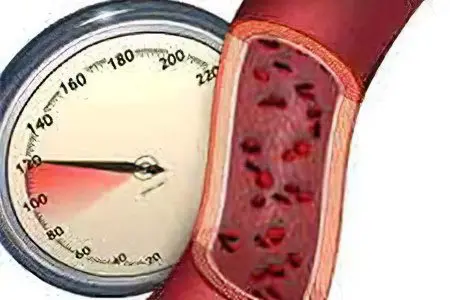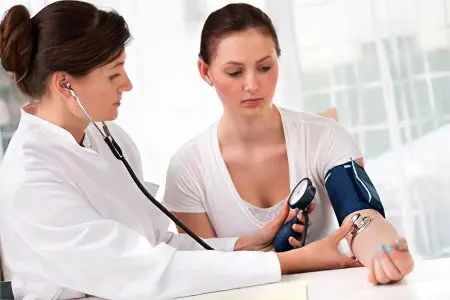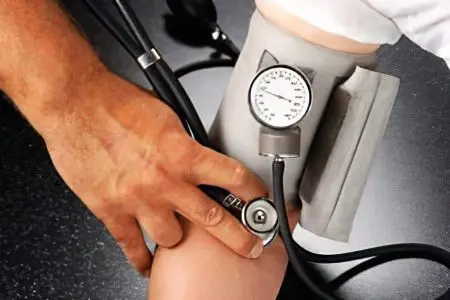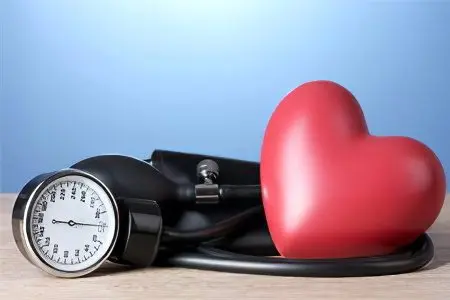Contents
A person is alive as long as his heart beats. The heart “pump” provides blood circulation in the vessels. In this regard, there is such a thing as blood pressure. In short, AD. Any deviation from normal blood pressure is deadly.
Risks of developing hypertension
The risk of developing hypertension or arterial hypertension – high blood pressure – consists of a number of factors. Accordingly, the more of them, the greater the likelihood that a person will become hypertensive.
Risk factors for developing hypertension:
hereditary predisposition. The risk of getting sick is higher for those who have hypertension among first-degree relatives: father, mother, grandparents, siblings. The more close relatives suffer from high blood pressure, the greater the risk;
male gender;
age over 35 years;
pregnancy;
stress (stress hypertension) and mental strain. The stress hormone adrenaline speeds up the heart rate. It instantly constricts blood vessels;
taking certain medications, for example, oral contraceptives, and various dietary supplements – dietary supplements (iatrogenic hypertension);
bad habits: smoking or alcohol abuse. The components of tobacco provoke spasms of blood vessels – involuntary contractions of their walls. This narrows the lumen of the blood flow;
atherosclerosis – blockage of blood vessels by plaque. Total cholesterol should not exceed 6,5 mmol / l of blood;
diabetes;
hypothalamic diseases;
pyelonephritis;
kidney failure (nephrogenic hypertension);
endocrinopathy of the adrenal glands, thyroid gland or pituitary gland;
excess salt in food. Table salt provokes a spasm of the arteries and retains fluid in the body;
immobility. Physical inactivity is accompanied by a slow metabolism – metabolism – and gradually weakens the body as a whole;
overweight. Each extra kilogram increases blood pressure by 2 millimeters of mercury – mm Hg;
sudden change in weather;
chronic lack of sleep and other “provocateurs”.

Most of the risk factors for developing hypertension are closely related. So, in heavy smokers in most cases atherosclerotic plaques appear, and physically passive and malnourished people quickly gain weight. Such combinations of factors significantly increase the risk of pathological abnormalities in the work of the heart.
Depending on the combination and degree of manifestation of the above factors, as well as the likelihood of cardiovascular complications in the next decade, there are 4 types of risk of developing arterial hypertension:
low (risk less than 15%);
medium (from 15 to 20%);
high (more than 20%);
very high (more than 30%).
Risk factors for the appearance of arterial hypertension are also divided into 2 varieties according to the possibility of their elimination: correctable (correctable) and not. For example, a person may well quit smoking, but he is not able to change his pedigree. The magnitude of the risk is summarized from a number of indicators. A patient with grade 1 hypertension who begins to abuse alcohol will significantly increase the percentage likelihood of developing complications.
Hypertension is quite treatable. Much here depends on the timely diagnosis of the disease, the persistence of the patient, his readiness to radically change his lifestyle.
Hypertension 1 degree

Arterial hypertension may be primary, i.e. develop independently, and secondary – to be a complication of another disease. In the latter case, the treatment is carried out in a complex, because it is necessary not only to normalize the pressure, but also to cure the concomitant disease-cause.
A blood pressure indicator of 120 per 80 mm Hg is considered normal. This is the “ideal” value, as they say, for astronauts. 120 – this is the so-called upper indicator of blood pressure or systolic pressure (with a maximum contraction of the walls of the heart muscle). And 80 is the lower indicator or the so-called diastolic pressure (with their maximum relaxation). Accordingly, hypertension is divided into systolic, diastolic and mixed (systolic-diastolic), depending on whether the upper or lower values exceed the threshold value.
With a narrowing of the lumen of the blood flow, the heart expends more effort to push the blood into the vessels, it wears out faster, starts to work intermittently. An increase in heart rate – heart rate – adversely affects the work of the whole organism. The air and nutrients contained in the blood do not have time to enter the cells.
Like any disease, hypertension progresses if left untreated. Prior to the appearance of the first hypertensive symptoms, the prehypertensive state is prehypertension.
The degree of its severity depends on the stage of development of the disease:
“soft” or light;
moderate or borderline;
heavy;
very severe or isolated systolic.
Otherwise, arterial hypertension of the 1st degree is called a mild form of this disease. The upper indicator of blood pressure ranges from 140 to 159, and the lower one is 90 – 99 mm Hg. Disorders in the work of the heart occur abruptly. Attacks, as a rule, pass without consequences. This is a preclinical form of hypertension. Periods of exacerbations alternate with the complete disappearance of the symptoms of the disease. During remission, the patient’s blood pressure is normal.
Diagnosis of hypertension is simple – it is the measurement of blood pressure using a tonometer. For an accurate diagnosis, the procedure is carried out three times a day in a calm atmosphere and in a relaxed state.
Even people at low risk of developing hypertension need to have their blood pressure checked regularly. One potentially dangerous factor is enough to closely monitor the work of your heart. For those who are predisposed to heart disease to a large extent, it is advisable to purchase a cardiovisor – an apparatus for taking ECG – electrocardiograms – at home. Any disease is easier to treat at an early stage.
Symptoms of hypertension 1 degree
Symptoms of grade 1 hypertension include:
headache that worsens with exertion;
dizziness up to fainting;
aching or stabbing pains on the left side of the chest, radiating to the shoulder blade and arm;
increased heart rate;
sleep disturbance;
noise in ears;
black dots before the eyes.
We must not forget that with a mild form of hypertension, all these symptoms appear occasionally. If, after a strong physical exertion, the pulse has become more frequent or it is difficult to fall asleep due to noisy neighbors, you should not panic and classify yourself as hypertensive.
During periods of improvement, the patient feels great. Mild hypertension has all the characteristic features of heart failure. More severe degrees of the disease differ only in the persistence of the manifestation of symptoms and the occurrence of complications.
Complications of hypertension 1 degree
Complications include:
microinfarctions of the brain;
renal sclerosis – nephrosclerosis;
hypertrophy of the heart muscle (left ventricle).
Most believe that mild arterial hypertension can be cured without consequences. But the risk of complications with grade 1 is average, i.e. about 15%. High pressure in the vessels due to the narrowing of their lumen leads to insufficient blood supply to the tissues. The lack of oxygen and nutrients leads to the necrosis of individual cells and entire organs. Necrosis begins with local, focal lesions. Over time, if left untreated, ischemic stroke is inevitable.
Circulatory disorders inevitably lead to metabolic disorders. This has a detrimental effect on the respiration and nutrition of cells of any type. Pathological changes are inevitable, for example, sclerosis – replacement by connective tissue. With nephrosclerosis, the walls of the kidney become pathologically compacted, the organ “shrinks”. In this regard, the excretory function is disturbed, and urea enters the bloodstream.
If the blood vessels are constricted, then the heart overworks to push blood through them. This leads to a pathological increase in the heart muscle. Such hypertrophy is called true or working. The volume and mass of the left ventricle increase due to the thickening of its walls. This pathology is otherwise called cardiomyopathy. The heart adapts its structure to the needs of the body. The extra muscle tissue allows it to compress more strongly. It would seem, what could be dangerous? A “swollen” heart can compress adjacent vessels, and uneven muscle growths close the exit from the left ventricle. Hypertrophy of the heart sometimes leads to sudden death.
Complications with hypertension of the 1st degree are extremely rare. To avoid them, it is enough to minimize the risk of developing arterial hypertension, i. eliminate its prerequisites, causes.
Treatment of hypertension 1 degree
First, the doctor will advise the patient to change their lifestyle. The patient will be advised to have restful sleep, avoid stress, targeted relaxation exercises, a special diet, exercise, etc. If these measures are not enough, drug therapy is used.
The following medications are prescribed by a cardiologist:
vasodilators;
neurotransmitters;
diuretics – diuretics;
anticholesterol – statins;
sedatives (sedatives) and other antihypertensive drugs.
Medicines are selected strictly individually, because. many hypertensive patients have comorbidities. The choice of drugs is influenced by the age of the patient and the drugs used by him.
If it is possible to stop the disease at the initial stage, completely get rid of it, in the future, prevention should not be neglected. Its principle is simple – it is the avoidance of all risk factors for the appearance of hypertension. Thanks to a healthy lifestyle, even hereditary pathologies can be prevented.
Hypertension 2 degree

This is moderate hypertension. The upper blood pressure is 160 – 179 mm Hg, and the lower one is 100 – 109 mm Hg. At this stage of the disease, periods of increased pressure are longer. BP rarely returns to normal.
Depending on the rate of transition of hypertension from one stage to another, benign and malignant arterial hypertension are distinguished. In the second, the disease progresses so rapidly that it is often fatal. Hypertension is dangerous because an increase in the speed of blood flow through the vessels leads to a thickening of their walls and an even greater narrowing of the lumen.
Symptoms of hypertension 2 degree
Typical signs of arterial hypertension appear even with a mild form of the disease.
In the second stage, the following symptoms join them:
chronic fatigue;
nausea;
sensation of pulsation in the head;
vascular insufficiency;
constriction of arterioles;
hyperemia – overflow of blood vessels, for example, redness of the skin;
sweating;
microalbuminuria – the presence of albumin proteins in the urine;
swelling of the face;
blurry vision;
numbness and chills of the fingers;
fundus pathology;
hypertensive crises – sudden jumps in pressure (sometimes by 59 units at once);
the appearance or aggravation of signs of damage to target organs.
Fatigue, lethargy and swelling appear because the kidneys are involved in the pathological process. A hypertensive attack may be accompanied by vomiting, urination and stool disorder, shortness of breath, tears. Sometimes it goes on for several hours. Complications of a hypertensive crisis are myocardial infarction and pulmonary or cerebral edema.
Forms of hypertensive crisis:
neurovegetative (increased heart rate, overexcitation, hand tremor, unmotivated panic, dry mouth);
edematous (lethargy, swelling of the eyelids, retarded consciousness);
convulsive (convulsions, fainting).
Symptoms of the 2nd degree of hypertension are more difficult for patients to tolerate. He constantly suffers from pathological manifestations of high blood pressure. The disease at this stage recedes reluctantly and often returns.
Complications of hypertension 2 degree
Complications of hypertension of the 2nd degree include the following diseases:
atherosclerosis;
cerebral thrombosis;
encephalopathy;
angina pectoris or angina pectoris;
aortic aneurysm – a pathological protrusion of its wall.
To target organs, i.e. internal organs affected due to hypertension include:
a heart;
blood vessels;
brain;
eyes;
kidney.
Hemorrhages in various organs occur because the walls of blood vessels thicken more and more, lose their elasticity and become brittle. Increased blood flow easily destroys such vessels. The reverse process occurs with the development of aneurysms. Here, the walls from increased blood circulation are stretched and thinned. They are so weak that they break easily.
A pathologically narrow lumen increases the likelihood of developing atherosclerosis – the deposition of fat on the walls – and thrombosis – clogging them with a thrombus. Bleeding of brain cells leads to oxygen starvation and their death. This phenomenon is called encephalopathy. Ischemia is oxygen starvation of the heart. Angina is persistent chest pain.
Pathological processes that have joined the underlying disease develop in connection with it. Accordingly, if treatment is not started in a timely manner or medical prohibitions are violated, there will be more and more target organs, and it will become almost impossible to restore health.
Disability hypertension grade 2

Hypertensive patients are on a permanent dispensary record and are periodically examined. In addition to daily pressure measurements, they are regularly prescribed an ECG. In some cases, ultrasound may be required – ultrasound of the heart, urine, blood tests and other diagnostic procedures. Hypertensive patients with a moderate form of the disease are less efficient than healthy people.
If there is a persistent violation of body functions due to hypertension, then the patient is sent to the bureau for examination to obtain the conclusion of a medical and social examination. In rare cases, hypertension is examined at home, in a hospital, or even in absentia. Sometimes a program of additional examination is drawn up. For the disabled, specialists from the Bureau of Medical and Social Expertise develop a mandatory individual rehabilitation program.
To determine the disability group, the expert commission, along with the degree of hypertension, takes into account the following factors:
complications;
information from the medical history of hypertensive crises;
working conditions of the patient.
The procedure for establishing a disability group is necessary for proper employment. Whether it will be easy to find an employer who is ready to put up with the work of an “inferior” employee is another question. If an applicant submits documents confirming disability during employment, then, according to federal law, he must be provided with the necessary working conditions.
Employers are reluctant to accept people with disabilities, because the working hours for them have been reduced while maintaining full pay (for groups 1 and 2). In addition, they are forced to take sick leave more often than other employees, and their annual leave has been increased. In this regard, most disabled people of the 3rd group hide their ailments in order to get a highly paid place. Violation of medical prescriptions regarding working conditions over time leads to an aggravation of the disease.
Disabled people of the 3rd group receive cash benefits and are allowed to work with some restrictions:
strong vibration and noise are contraindicated;
it is impossible to work overtime, on weekends or on a night shift without the consent of the employee;
constant physical or psycho-emotional stress is not allowed;
prohibition of work at high altitude, in hot shops, near dangerous mechanisms;
reducing the duration of work associated with a high concentration of attention;
seven hour work day.
A special case is malignant arterial hypertension of the 2nd degree. Its development is so rapid, and the patient’s condition is difficult, that the commission assigns him a disability of the 2nd group. This is no longer a working group. With 2 and 3 degrees of disability, a medical and social examination is carried out annually. Persons with disabilities of the following categories are exempted from re-examination:
men over the age of 60;
women over the age of 55;
people with irreversible anatomical defects.
The assignment of a disability group is caused by the need for social protection of hypertensive patients. His ability to work is limited.
Treatment of hypertension 2 degree
At this stage of the disease, medication is no longer necessary. Tablets are taken regularly, if possible at the same time of day. The patient should not think that to get rid of the disease it will be enough just to take medications. If he does this while simultaneously indulging in, for example, fatty foods and alcohol, the positive effect of therapy will quickly disappear. The disease will move to the next stage, at which any treatment is already ineffective.
Hypertension 3 degree

Why are doctors concerned about the deviation of blood pressure indicators from the norm even by one? The fact is that with an increase in pressure by several units, the risk of developing cardiovascular complications increases by the same percentage. For example, if a person has mild hypertension and the blood pressure has deviated from the normal 120 over 80 mm Hg. by 39 units, then the probability of occurrence of pathological deviations from various organs is very high (39%). What then can be said about the 3rd degree of the disease, in which the deviation is at least 60 units?
Hypertension of the 3rd degree is a severe, chronic form of the disease. BP rises above 180/110 mm Hg, it never drops to the normal 120/80. Pathological changes are already irreversible.
Symptoms of hypertension 3 degree
Symptoms of grade 3 hypertension include:
arrhythmia;
change in gait;
violation of coordination of movements;
persistent visual impairment;
paresis and paralysis in violation of cerebral circulation;
prolonged hypertensive crises with speech disorders, clouding of consciousness and sharp pains in the region of the heart;
hemoptysis;
a significant limitation in the ability to independently move, communicate and serve themselves.
In severe cases, hypertension can no longer do without outside help, they need constant attention and care. The above signs of hypertension show that the patient’s health is gradually deteriorating, the disease covers new organ systems, and there are more and more complications.
Complications of hypertension 3 degree
Complications of hypertension of the 3nd degree include the following diseases:
myocardial infarction – the middle muscle layer of the heart;
cardiac asthma – attacks of suffocation;
heart failure;
stroke;
defeat of peripheral arteries;
pulmonary edema;
hypertensive retinopathy affects the retina;
scotoma (“darkness”) – a defect, a blind spot in the field of vision;
blindness;
diabetic nephropathy;
kidney failure;
nephroangiosclerosis.
Complications of arterial hypertension of the 3rd degree are otherwise called associated clinical conditions. In violation of cerebral circulation, a stroke develops, accompanied by loss of sensation in the limbs and fainting. Heart failure is a whole complex of pathologies of the heart. Kidneys gradually fail. If hypertension is a secondary disease and arose against the background of diabetes mellitus, then nephropathy is inevitable.
The more advanced the disease, the worse and more severe its consequences. The circulatory system is so important for the life of the body that the slightest deviation in its work gives a powerful destructive effect.
Disability hypertension grade 3
With a severe form of the disease, 1 disability group is established. At this stage, patients are practically unable to work. Sometimes they are recognized as partially able-bodied and continue to work, but only at home or in special conditions.
But even with the most severe degree of disability, the patient must undergo rehabilitation procedures. In this state of affairs, this is necessary to prevent a fatal outcome.
Treatment of hypertension 3 degree
With the aggravation of the course of the disease, more and more potent drugs are prescribed or their list remains the same, but the dosage increases. At this stage of hypertension, the effect of drug therapy is minimal. Chronic hypertensive patients are doomed to drink pills for life.
When the disease becomes severe, surgery may be required. The operation is indicated for certain pathologies of blood vessels and the heart. The method of stem cell therapy for arterial hypertension of the 3rd degree is considered to be innovative.
Hypertension 4 degree
Some experts also distinguish the 4th stage of the disease, which is very severe. In most cases, death is close. They try to alleviate the suffering of the patient as much as possible, and at every hypertensive crisis provide first aid. The patient is placed, raising his head. He is urgently given medication that sharply lowers the pressure.
In the absence of treatment, new complications appear. Some of them provoke others, and diseases more and more overcome a person. In order to stop this destructive process in time, you just need to monitor the dynamics of changes in your blood pressure, at least with the help of a conventional tonometer.









